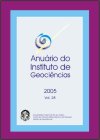Holocenic calcareous biolaminoids of the Vermelha lagoon, Brazil
DOI:
https://doi.org/10.11137/2005_2_59-70Abstract
Lagoa Vermelha lies within the coordinates 22º55'39 - 22º56'06 S and 42º2129 - 42º24'13 W and is part of Araruama lagoon complex. Its dimensions are 4,400 m in length, 250 - 850 m in width, with approximate area of 2,400 m² and 0,2 - 1,7 m in depth. The study was based on six monthly collections in five stations over the north - east lagoon's margins from where was taken 20 samples of biolaminoids. To determinate the microbial composition of all different kinds of biolamonoids was made fresh and permanent slides and its analysis was carried out by microscopy. It was found three different kinds of microbial mats distributed throughout all five stations and were called: flat, polygonal and pustuled. Flat and polygonal microbial mats show itself layered, while pustuled show homogeneous structures. Layered and homogeneous ones present the same kind of main cyanobacterias, however layered mats in superficial stratum show preponderance of filamentous species and coccoid species in the bottom. Analysis showed a total of 33 species of cyanobacterias confirming it as main biolaminod component.The flat biolaminoid was mainly formed by Lyngbya aestuarii, the polygonal biolaminoid showed itself composed by Microcoleus chthonoplastes and the pustular biolaminoid was characterized by the presence of the cyanobacteria Chlorogoea tuberculosa. The cyanobacterial dominance is justified through its high morphologic adaptations that ensure its survival in many environments and prevail over in hipersaline local.Downloads
Download data is not yet available.
Downloads
Published
2005-01-01
How to Cite
Silva e Silva, L. H. da and Carvalhal, S. B. V. (2005) “Holocenic calcareous biolaminoids of the Vermelha lagoon, Brazil”, Anuário do Instituto de Geociências. Rio de Janeiro, BR, 28(2), pp. 59–70. doi: 10.11137/2005_2_59-70.
Issue
Section
Article
License
This journal is licensed under a Creative Commons — Attribution 4.0 International — CC BY 4.0, which permits use, distribution and reproduction in any medium, provided the original work is properly cited.















